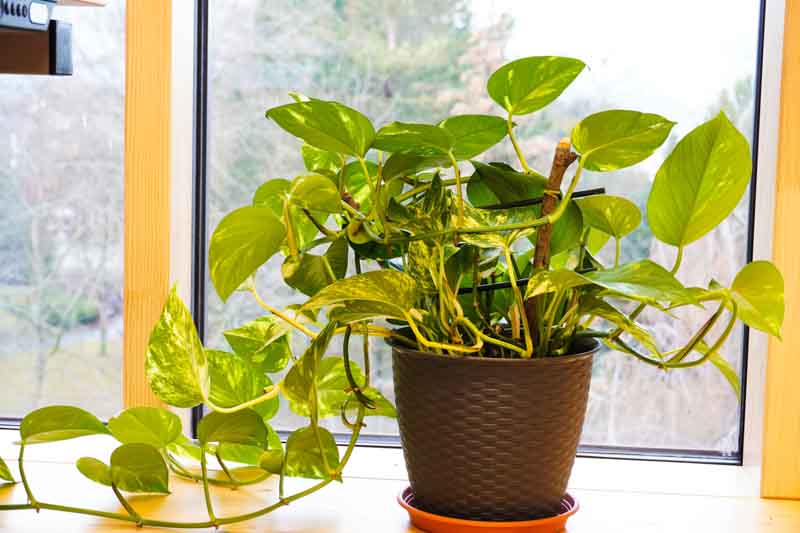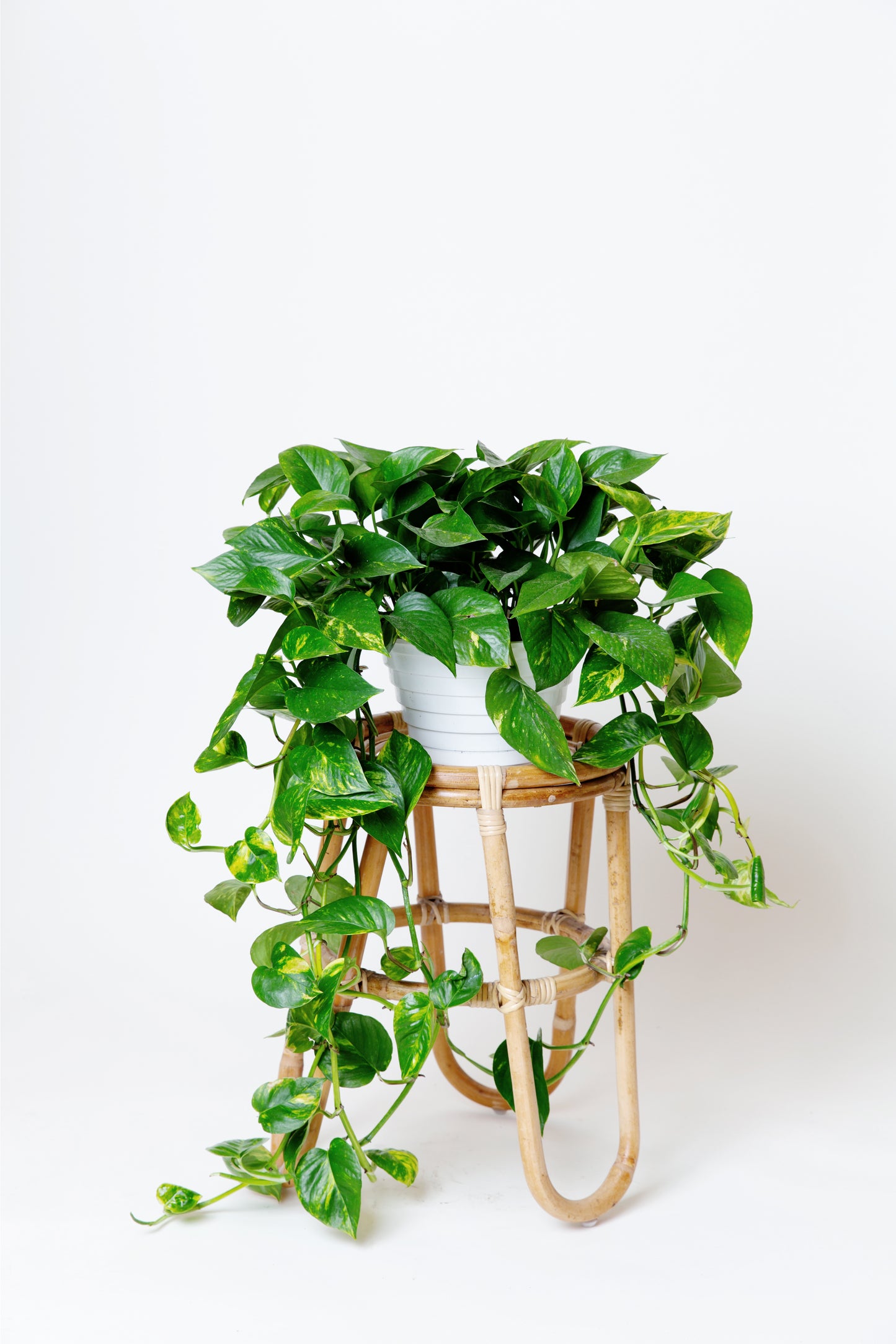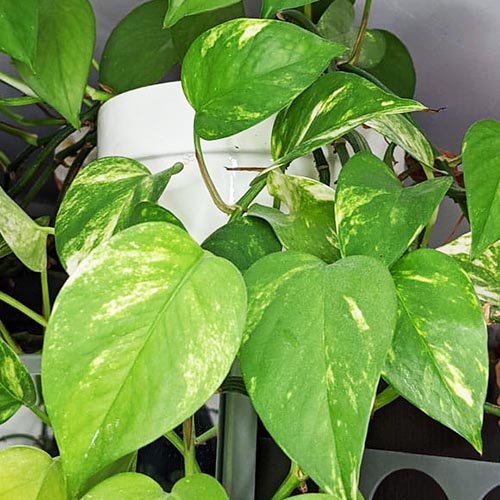Epipremnum Aureum: Care Tips for Thriving Devil’s Ivy Plants. Discover how to care for your plants with our guide on Epipremnum Aureum: Care Tips for Thriving Devil’s Ivy Plants. Keep your Devil’s Ivy lush & green!

Origin & Characteristics of Epipremnum Aureum
Epipremnum Aureum, commonly known as Devil’s Ivy or Pothos, originates from the islands of French Polynesia & has garnered popularity worldwide due to its lush, green foliage & resilience. Typically characterized by heart-shaped leaves, Devil’s Ivy can display a range of variegated patterns, featuring hues of green, yellow, or even white. These variations make this plant visually appealing for homes & offices alike. In its natural habitat, it thrives in humid conditions, often seen climbing trees & rocks, which contributes to its reputation as a hardy climbing vine.
The adaptability of Epipremnum Aureum allows it to flourish in various environments, ranging from shaded areas to bright indirect light. This flexibility contributes to its status as a favored indoor plant. With a growth height of anywhere between 20 to 40 feet in the wild, it can also be maintained at manageable sizes for indoor gardening. Proper care of this plant can enhance its natural beauty & increase its longevity.
Light Requirements for Devil’s Ivy
<pLighting plays a crucial role in the thriving of Epipremnum Aureum. While this plant is adaptable, it thrives best in bright, indirect light. Too much direct sunlight can scorch the leaves, leading to browning & drying, while too little light can slow growth & result in smaller leaves. The ideal location includes areas such as east or north-facing windows where they can bask in gentle light.
For indoor enthusiasts, fluorescent bulbs are an excellent alternative when natural light is limited. Placing the plant approximately 2-4 feet from a light source can foster healthy growth. Signs that your plant is receiving inadequate light may include leggy growth, where the stems stretch significantly between leaves, or yellowing leaves signaling stress. Ensuring optimal lighting conditions is essential for the vibrant growth of your Devil’s Ivy.
Best Practices for Watering Epipremnum Aureum
Watering Epipremnum Aureum requires a balanced approach. This plant typically prefers to dry out slightly between watering sessions. A common practice is to check the top inch of the soil; if it feels dry, it’s time to water. Overwatering can lead to root rot, a significant risk for indoor plants. Conversely, underwatering may cause the leaves to droop & lose their turgidity.
When it comes to frequency, during the growing season (spring & summer), watering may be required once a week. Be that as it may, this can vary based on environmental conditions think humidity & temperature. In colder months (autumn & winter), watering intervals can extend to every two weeks. Incorporating a well-draining potting mix is vital to avoid water stagnation. Employing pots with drainage holes also helps maintain healthy root moisture levels.
Soil Preferences for Thriving Devil’s Ivy
The choice of soil significantly influences the prosperity of Epipremnum Aureum. A well-draining potting mix is paramount to prevent moisture retention around the roots. A mixture designed for both indoor plants & cacti can provide the ideal environment, as it includes materials like perlite or coarse sand, which enhance drainage capabilities. Soil pH should ideally range between 6.0 & 6.5, slightly acidic to neutral, which supports proper nutrient absorption.
Commercial potting mixes often suffice, but gardeners seeking a custom blend can mix equal parts of potting soil, peat moss, & perlite for optimal consistency. Regularly checking the soil’s health by observing moisture levels will inform when it’s time to refresh or replace the soil, keeping the plant healthy & thriving.
Nutrient Requirements for Epipremnum Aureum
Nourishment is key to the flourishing of Devil’s Ivy. This resilient plant thrives with routine fertilization, particularly during its active growing season. Utilizing a balanced, water-soluble fertilizer every four to six weeks promotes robust leaf growth. A fertilizer with equal parts nitrogen, phosphorus, & potassium is recommended, applying at half the recommended strength to prevent fertilizer burn.
In the fall & winter months, as growth slows, the frequency of fertilizer application can taper off. Observing the leaves can help identify deficiency signs yellowing leaves often suggest a need for additional nitrogen, while poor root development may indicate phosphorus scarcity. Healthy fertilization routines are essential for maintaining the vibrant appearance of your Epipremnum Aureum.
Temperature & Humidity Needs for Thriving Devil’s Ivy
Epipremnum Aureum thrives in warm & humid environments. Ideal temperatures range from 65°F to 85°F (18°C to 29°C), making it an appropriate choice for most domestic settings. Sudden temperature fluctuations, particularly cold drafts or heating vents, should be avoided as they stress the plant & can cause leaf drop.
Humidity levels exceeding 50% benefit the health of this tropical plant. Supplying additional humidity can be achieved with the use of a pebble tray filled with water beneath the pot, or placing the plant in a bathroom or kitchen where moisture levels are typically higher. Misting the leaves can also help, but this should not replace regular watering. Monitoring dryness in the air is crucial, especially in heating or air conditioning season, to prevent brown leaf tips.
Pruning & Maintenance for Epipremnum Aureum
Regular pruning plays a pivotal role in the health & aesthetics of Epipremnum Aureum. Trimming the plant encourages bushier growth & helps maintain its desired size. Unruly vines can be curbed by pinching back excessive growth at the tips of the stems. Alongside enhancing the beauty of the plant, this activity also helps to improve air circulation & reduces the risk of pest infestations.
Timing for pruning typically aligns with the growing season, from spring to early fall, when the plant is most actively producing new leaves. It’s essential to use clean, sharp scissors to avoid injury to the plant & the spread of diseases. And another thing, dead or yellowing foliage should be promptly removed to redirect energy to healthier parts of the plant.
Common Pests & Diseases Affecting Epipremnum Aureum
<pEpipremnum Aureum, while hardy, can face pest challenges. Common offenders include spider mites, mealybugs, & aphids. Regularly inspecting leaves for webbing, sticky residues, or discolored foliage can help detect problems early. Treatments may involve wiping down leaves with a damp cloth or applying insecticidal soap as needed. Maintaining high humidity levels not only fosters healthy growth but can also help deter pests.
Fungal infections can also afflict Devil’s Ivy, particularly when overwatered or in low-light conditions. Leaf spots or wilting can indicate issues that should be addressed promptly. Implementing proper watering techniques, ensuring adequate sunlight, & practicing good air circulation are practical measures to prevent disease. An informed & proactive approach can help keep your Epipremnum Aureum flourishing.
Propagation Techniques for Devil’s Ivy
Propagation of Epipremnum Aureum is straightforward & rewarding. Stem cuttings are the most common method, as they root easily in water or soil. For successful cuts, select a healthy stem with several leaves, ensuring that at least one node is included in the cutting. Cut approximately 4-6 inches in length & place the cutting in a glass of water, where roots will develop within 2-4 weeks.
Once roots establish, the new plant can be transferred to the soil. In a different context, cuttings can be placed directly into a well-draining potting mix, which may take longer to root but reduces transplant shock. Whether producing new plants for personal enhancement or sharing with friends, propagation is a satisfying aspect of cultivating Epipremnum Aureum.
Potential Toxicity of Epipremnum Aureum
While Epipremnum Aureum is a fantastic indoor plant, it’s essential to note that it is mildly toxic to pets & humans if ingested. Contains calcium oxalate crystals that may cause irritation to the mouth & throat. Signs of toxicity include swelling, difficulty swallowing, & nausea. It is prudent to place the plant out of reach of children & pets, or consider alternative plants if these concerns exist.
If ingestion does occur, consulting with a healthcare professional or veterinarian can provide appropriate guidance. Awareness about the potential risks of Devil’s Ivy enables safe enjoyment of its ornamental qualities.

Introduction to Epipremnum Aureum
The Epipremnum Aureum, commonly referred to as Devil’s Ivy, has gained immense popularity among plant enthusiasts. This resilient & visually striking houseplant is known for its lush green leaves that possess variegated patterns. Whether you are a seasoned gardener or a novice, learning how to care for these plants will help you achieve vibrant growth & lush foliage. You’ll find that with a little attention & understanding of their needs, your Devil’s Ivy can flourish beautifully in your home.
Light Requirements of Devil’s Ivy
Devil’s Ivy thrives in various lighting conditions, making it an ideal choice for many indoor settings. These plants prefer bright, indirect light but can also adapt to low-light environments. Be that as it may, prolonged exposure to direct sunlight may scorch the leaves, causing discoloration. A spot near an east or north-facing window is often ideal for your Epipremnum Aureum, while a south-facing window may suffice as long as the bright sunlight is filtered. If you’re noticing the plant stretching towards the light source, it may be a sign that it’s not receiving enough brightness. To ensure optimal growth, plan to rotate the plant every few weeks to promote balanced exposure on all sides.
Watering Techniques for Epipremnum Aureum
Watering plays a crucial role in the health of your Devil’s Ivy. These plants prefer to dry out slightly between waterings. Overwatering is one of the most common issues faced by plant owners, often leading to root rot. Check the top inch of the soil; if it’s dry, it’s time to water. Use room-temperature water & ensure that the pot has proper drainage to prevent water from accumulating at the bottom. In general, watering every 1-2 weeks is sufficient, but this may vary based on factors such as the plant’s size & environmental conditions. During the winter months, watering frequency can be reduced as the plant enters a dormant phase.
Soil Selection for Devil’s Ivy
The right soil mixture is essential for the growth of Epipremnum Aureum. These plants prefer a well-draining potting mix to promote healthy root development. A blend of peat moss, perlite, & pine bark works well, providing aeration & moisture retention. You can also use a specialty aroid mix, if available. Avoid heavy garden soils that retain too much water, as they can lead to root rot. Regularly refreshing the soil will also ensure that the plant receives adequate nutrients. With the right soil, your Devil’s Ivy will establish a robust root system, supporting its lush foliage.
Humidity & Temperature Preferences
Devil’s Ivy enjoys a humid environment, ideally around 40-60% humidity. While these plants can tolerate average household humidity levels, they may benefit from extra moisture, especially in dry conditions. To increase humidity, consider placing a humidifier nearby or grouping your plants together. In a different context, you can use a pebble tray filled with water beneath the pot to create a microenvironment. Regarding temperature, Epipremnum Aureum thrives in a range of 70°F to 90°F (21°C to 32°C). Ensure they are protected from cold drafts & sudden temperature changes, which can stunt growth or cause stress to the plant.
Fertilizing Your Epipremnum Aureum
Regular fertilization can significantly enhance the growth of your Devil’s Ivy. During the growing season, from spring to summer, applying a balanced, water-soluble fertilizer once every month helps provide essential nutrients. Use half the recommended strength to prevent fertilizer burn, which can damage the plant. In the fall & winter months, decrease fertilization as the plant’s growth slows down. If you notice slow growth or pale leaves, your plant might require more nutrients. Diluting the fertilizer in water & applying it gradually ensures your Epipremnum Aureum receives everything it needs without overwhelming it.
Pest Control for Devil’s Ivy
One of the most common concerns for Epipremnum Aureum owners is pest infestations. Common pests include spider mites, mealybugs, & aphids. Regularly inspect your plant for signs of these pests, such as webbing or sticky residue. To manage these critters, a gentle spray of water can help dislodge them. For more stubborn infestations, using insecticidal soap or neem oil may be necessary. Always follow the manufacturer’s instructions for application. Keeping your plants clean, including wiping the leaves with a damp cloth, can help prevent pest issues from taking root.
Pruning & Maintaining Your Devil’s Ivy
Pruning is an essential aspect of maintaining your Epipremnum Aureum. Regular pruning helps promote bushier growth & keeps the plant healthy. This process involves trimming back long vines & removing any yellowing or damaged leaves. It’s a good idea to prune during the growing season, as this encourages new growth. Use sharp, sterile shears to avoid damaging the plant or introducing pathogens. After pruning, consider propagating the cuttings by placing them in water or a suitable potting mix, allowing you to expand your collection. As your Devil’s Ivy grows, you can rearrange its structure to fit your decor effectively.
Potting & Repotting Your Epipremnum Aureum
Choosing the right pot & repotting your Devil’s Ivy at the right time is critical for plant health. Select a pot with drainage holes, as this helps prevent water accumulation. As the plant grows, it becomes necessary to repot every 1-2 years or when you notice that roots are emerging from the drainage holes. When repotting, gently shake off old soil & inspect the roots for any signs of damage. Use fresh potting soil to replenish nutrients. Repotting not only refreshes the soil but also provides the plant with more space to grow, ensuring its longevity & vibrancy.
| Common Pests | Identification Signs |
|---|---|
| Spider Mites | Fine webbing on leaves |
| Mealybugs | Cotton-like formations on stems & leaves |
| Aphids | Droplets of honeydew & curled leaves |
Environmental Adaptability of Epipremnum Aureum
One of the remarkable features of Devil’s Ivy is its adaptability to various environmental conditions. This plant can thrive in a wide range of temperatures & humidity levels, making it suitable for both novice & experienced plant owners. Whether you live in a high-humidity climate or a drier area, your Epipremnum Aureum can adjust. Indoor settings with varying light conditions will not deter this plant’s growth, making it an excellent choice for homes & offices. It can even trail or climb, adapting to your chosen support structures effectively.
Common Variations of Devil’s Ivy
There are several varieties of Epipremnum Aureum, each with unique characteristics. Some popular variations include:
- Golden Pothos: Bright yellow flecks on leaves.
- Neon Pothos: Vibrant, electric green leaves.
- Marble Queen: White & green variegated foliage.
- Jade Pothos: Deep green, solid-colored leaves.
Understanding these variations can enhance your collection & provide options for different aesthetic preferences. Each type requires similar care but may display different growth patterns & light preferences.
“Understanding how to care for Epipremnum Aureum is essential for every plant lover who wishes to enjoy the beauty of Devil’s Ivy.” – Everett Bashirian
Personal Experience with Devil’s Ivy
My experience with Epipremnum Aureum has been incredibly rewarding. I still remember the day I picked up my first Devil’s Ivy from the local nursery. Its vibrant green leaves instantly attracted me. I experimented with different lighting conditions & watering schedules to find the best care for my plant. Watching it grow & thrive gave me immense satisfaction. Over time, I learned the importance of attention, from humidity to fertilization, which all contributed to the plant’s overall health. I even managed to propagate a few cuttings to share with friends, & it was fulfilling to see them enjoy this lovely plant as much as I do.

What type of light is best for Epipremnum Aureum?
Epipremnum Aureum thrives in bright, indirect light. Be that as it may, it can tolerate lower light conditions, making it versatile for various indoor environments.
How often should I water my Devil’s Ivy?
Water your Devil’s Ivy when the top inch of soil feels dry. Typically, this will be every 1-2 weeks, depending on humidity & temperature.
What soil is suitable for Epipremnum Aureum?
A well-draining potting mix is ideal for Epipremnum Aureum. A mix that contains peat, pine bark, & perlite works well to prevent waterlogging.
Can I grow Devil’s Ivy in water?
Yes, Epipremnum Aureum can be propagated & grown in water. Just ensure the cuttings are submerged & change the water regularly to keep it fresh.
Does Epipremnum Aureum need fertilizer?
Fertilizing during the growing season with a balanced liquid fertilizer every 4-6 weeks can support healthy growth & development.
What temperature range is best for Devil’s Ivy?
Epipremnum Aureum prefers temperatures between 60°F & 85°F (15°C to 29°C) & should be protected from cold drafts.
How do I prune my Devil’s Ivy?
To prune Epipremnum Aureum, remove any yellow or damaged leaves & cut back leggy growth to promote bushier foliage.
Is Epipremnum Aureum toxic to pets?
Yes, Epipremnum Aureum is toxic to cats & dogs. If ingested, it can cause mild gastrointestinal upset, so keep it out of reach of pets.
How can I encourage bushier growth in my Devil’s Ivy?
Pinching back the tips of the stems encourages branching & results in a fuller plant. Regular pruning helps maintain bushiness.
What pests should I watch out for?
Common pests include spider mites, mealybugs, & aphids. Regular inspection & treatment with insecticidal soap can help manage infestations.
Conclusion
Taking care of your Epipremnum Aureum, or Devil’s Ivy, is quite simple & enjoyable. With just a few key tips, you can help your plant thrive beautifully. Ensure it gets enough light, water it enough without making it soggy, & feed it occasional nutrients. Pruning can help keep it looking neat. Remember, this plant is known for its ability to grow in various conditions, so don’t stress too much if your setup isn’t perfect. Enjoy the greenery & watch your plant flourish. With a little love, you’ll have a happy & healthy Devil’s Ivy in your space.
